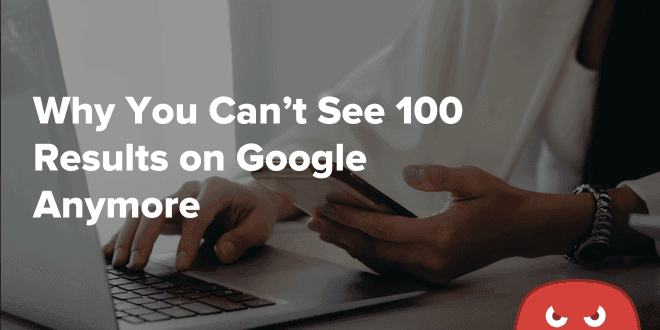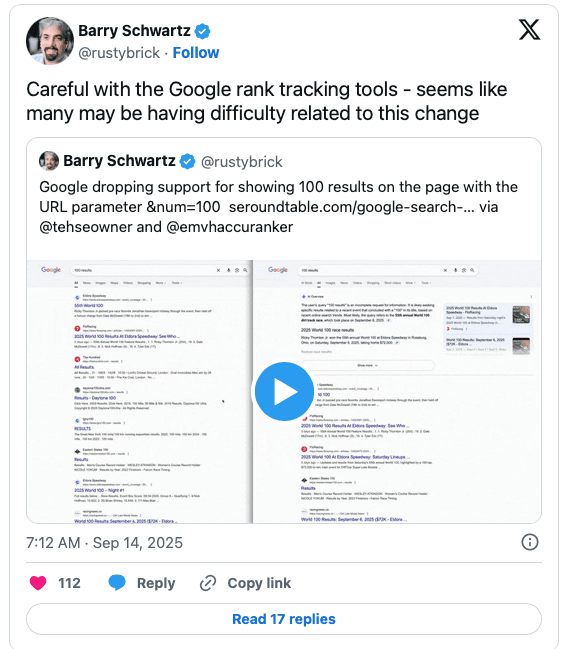
 Also, it now takes 10 requests to obtain the same amount of data you used to get with just 1 request.
This has put a massive strain on third-party tracking tools like Ahrefs and Semrush. At this point, they’ve already released statements reassuring users that they’re finding ways to adapt to this new change.
However, the results have been significant already:
Also, it now takes 10 requests to obtain the same amount of data you used to get with just 1 request.
This has put a massive strain on third-party tracking tools like Ahrefs and Semrush. At this point, they’ve already released statements reassuring users that they’re finding ways to adapt to this new change.
However, the results have been significant already:
- 77% of websites lost unique ranking terms (Search Engine Land)
- 87.7% saw declines in impressions (Search Engine Land)
- Third-party rank tracker dashboards have broken, causing inconsistent or missing tracking data beyond page 1
Why Did Google Remove the Parameter?
 So far, Google has not officially stated why they removed the &num=100 parameter, only that ‘it’s not something they support.’
While this is technically true, Google had unofficially supported the parameter for a very long time, even after removing the interface that tells Google how many results you want to display back in 2018.
Why they chose to abruptly discontinue the feature remains a mystery, although speculation has run amok online.
Here are some of the most common theories:
So far, Google has not officially stated why they removed the &num=100 parameter, only that ‘it’s not something they support.’
While this is technically true, Google had unofficially supported the parameter for a very long time, even after removing the interface that tells Google how many results you want to display back in 2018.
Why they chose to abruptly discontinue the feature remains a mystery, although speculation has run amok online.
Here are some of the most common theories:
- Curtailing bulk SERP harvesting from scrapers. The &num=100 parameter meant any scraper tool (not just SEO tools) could grab 100 search results in a single request. This presented a goldmine for companies gathering training data for LLMs. For example, they could use the parameter to fetch 100 long-tail keyword results, which are perfect for teaching AIs how people phrase questions and expect answers.
- Easing the resource strain. Every time a tool used the &num=100 parameter, Google’s systems were forced to display 100 results at a time. This is incredibly resource-heavy, so Google may have removed the parameter to save energy.
- Aligning with user experiences to provide more accurate data. The average search user does not view 100 results at a time, so Google may have made the change to make GSC data more accurate (more on this below).
- Safeguarding Google’s AI dominance. Google is leading the AI search game with its AI Overviews powered by Gemini. As a result, the company probably didn’t want to give its competitors the ability to rapidly train their LLMs with 100 results at a time.
How Does This Change Affect SEO?
Since Google was so tight-lipped on the matter at first, it was hard to tell if the change was accidental or on purpose. With their official statement being, “We do not support the &num=100 parameter,” it’s highly likely that the change is here to stay. This has undoubtedly thrown a wrench into the way rank tracking tools work, especially by forcing more pagination requests. Tools will now have to paginate 10 separate pages, each with 10 results per page. That means the cost of rank tracking will go up, which may lead to some providers increasing their subscription fees.
The change may also impact data freshness.
It will take twice as long to collect large groups of keywords, which can lead to reporting delays and outdated data.
If third-party tools fail to adapt, the quality of their reporting will rapidly decrease, causing inaccuracies and incomplete data.
However, there is one positive change.
While Google Search Console saw massive drops in impressions, its data will likely become more accurate due to the removal of the &num=100 parameter.
Let’s explain.
Whenever scrapers used the parameter to display 100 results at a time, GSC logged ‘impressions’ for results 11 - 100. This caused an inflated amount of impressions in GSC, which is why they sharply decreased for most websites when the parameter was removed.
The silver lining is that GSC data will be MORE accurate now since it will align better with the experiences of most users (who only view 10 results at a time).
Tools will now have to paginate 10 separate pages, each with 10 results per page. That means the cost of rank tracking will go up, which may lead to some providers increasing their subscription fees.
The change may also impact data freshness.
It will take twice as long to collect large groups of keywords, which can lead to reporting delays and outdated data.
If third-party tools fail to adapt, the quality of their reporting will rapidly decrease, causing inaccuracies and incomplete data.
However, there is one positive change.
While Google Search Console saw massive drops in impressions, its data will likely become more accurate due to the removal of the &num=100 parameter.
Let’s explain.
Whenever scrapers used the parameter to display 100 results at a time, GSC logged ‘impressions’ for results 11 - 100. This caused an inflated amount of impressions in GSC, which is why they sharply decreased for most websites when the parameter was removed.
The silver lining is that GSC data will be MORE accurate now since it will align better with the experiences of most users (who only view 10 results at a time).
What Should You Do Next? A Shift in Perspective
 It’s always concerning (and even panic-inducing) whenever there are sudden disruptions to how you monitor your SEO performance.
However, it’s crucial to remain calm and hang tight during this transition.
As mentioned before, most third-party tracking tools are racing to adapt to this change, and GSC data is actually becoming more accurate.
Moreover, the importance of traditional organic rankings (the blue links) has become diminished due to the prominence of AI-driven search features.
It’s now just as important to track metrics like:
It’s always concerning (and even panic-inducing) whenever there are sudden disruptions to how you monitor your SEO performance.
However, it’s crucial to remain calm and hang tight during this transition.
As mentioned before, most third-party tracking tools are racing to adapt to this change, and GSC data is actually becoming more accurate.
Moreover, the importance of traditional organic rankings (the blue links) has become diminished due to the prominence of AI-driven search features.
It’s now just as important to track metrics like:
- Visibility in AI Overviews
- Share of voice in SERPs and AI search results
- AI citations from tools like ChatGPT and Perplexity
The author
Rachel Hernandez
description
Previous
Pros and Cons of ChatGPT in 2025: What Businesses Should Know
Next
The Three Tiers of Brand Mentions in AI Search (and How to Build Them)
Discussion
Comments
MD Mostafa Niloy
October 28th, 2025
Thanks for this insightful article!
orexis
October 7th, 2025
thank you for informative content
Orexis Digital Marketing Agency Calicut, Kerala build successful strategies. And that help you to increase customers and business.Louise Savoie
September 29th, 2025
I was wondering why I couldn’t scroll through as many results as before. This makes so much sense now! It really shows how important it is to rank on the first few pages since people don’t see as many results anymore. Thanks for explaining it in such a clear way!
